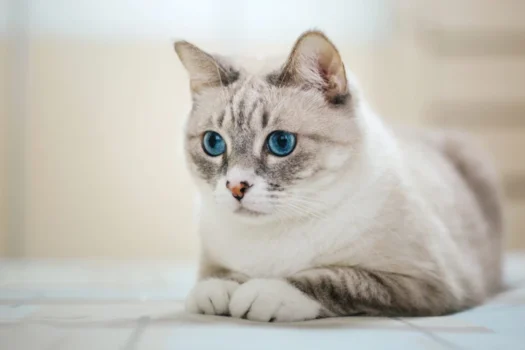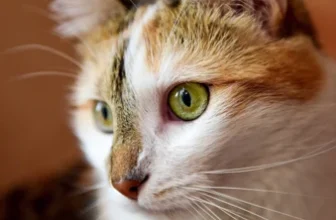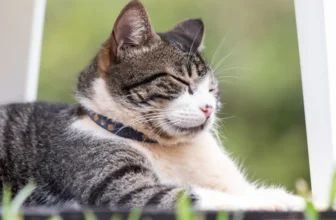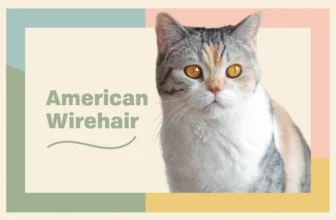The American Wirehair is a unique breed of cat with a coat that stands out from the rest. Their coat is different from other cats due to its texture, density, and color, making it one of the most interesting features of this feline. If you’re considering adopting an American Wirehair or already have one, it’s essential to understand the characteristics of their coat and how to care for it properly. In this article, we will dive into the details of what makes this breed’s coat so special and what you need to know to keep it healthy and shiny.
Physical Characteristics
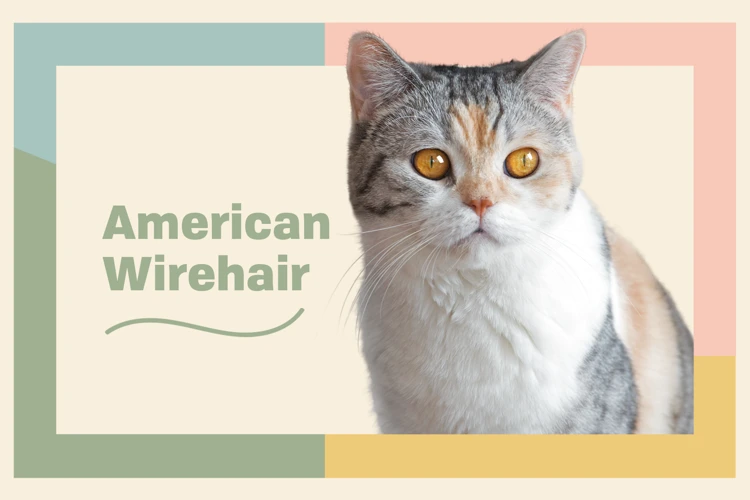
The American Wirehair is a breed with a unique coat that stands out among other breeds. This breed originated in the United States, and its coat characteristics have been carefully studied by experts in the field. From texture to color, the American Wirehair’s coat has caught the attention of many cat lovers. Understanding the physical characteristics of this breed’s coat is not only a fascinating topic, but it can also help owners learn how to take better care of their pets. Let’s dive into the details of this exceptional breed.
Texture
The American Wirehair is a unique breed of cat known for its distinctive coat texture. The texture of an American Wirehair’s coat is often described as hard and springy. The combination of its unique coat texture and dense fur gives the American Wirehair a soft and springy feel that is different from other cat breeds.
The texture of an American Wirehair’s coat is due to a dominant trait that arose spontaneously in a litter of barn cats in upstate New York. This dominant trait changes the structure of the hair follicles, resulting in a wire-like texture. While it is believed that the texture of an American Wirehair’s fur is a result of the climate and environment in which the breed was developed, there is little scientific evidence to support this theory.
The texture of an American Wirehair’s coat can vary slightly among individuals. Some cats may have a more wiry texture, while others may have a softer feel. It is important to note that the texture of an American Wirehair’s coat is not related to the color or pattern of its fur.
Table: Comparing the Texture of American Wirehair Coat with Other Breeds
| Breed | Texture |
|---|---|
| American Wirehair | Hard and springy |
| Persian | Soft and fluffy |
| Sphynx | Suede-like and velvety |
| Siamese | Short and sleek |
Maintaining the texture of an American Wirehair’s coat requires regular grooming. Due to the texture of their fur, they are prone to matting if not regularly brushed and combed. Grooming not only prevents matting but also helps distribute the natural oils in a cat’s fur, providing a healthy shine and maintaining coat texture. To learn more about effective grooming methods for an American Wirehair, check out our article on how to groom an American Wirehair coat.
While the texture of an American Wirehair’s fur is not directly related to any health issues, it should be noted that cats with wiry or curly fur are susceptible to developing hairballs. Regular brushing and grooming can help prevent hairballs and keep your cat’s coat healthy.
The unique texture of an American Wirehair’s coat is one of its most distinctive characteristics. Regular grooming and maintenance are essential to preserving the texture and overall health of their coat. Understanding the genetics and evolution behind these unique traits can help us better appreciate and care for this fascinating breed. To learn more, be sure to check out our articles on the genetics of American Wirehair coat texture and separating fact from fiction regarding American Wirehair coat myths.
Density
When it comes to the American Wirehair breed, the density of their coat is another unique characteristic worth discussing. The coat of an American Wirehair is usually thicker than other cat breeds. The thickness of their coat can vary depending on the individual cat and can change seasonally.
According to the Cat Fanciers’ Association standard, the American Wirehair’s coat should be “densely covered in springy, resilient hair with the hair standing out from the body due to its crimped and hooked texture.” This texture is what sets them apart from any other breed.
Here is a breakdown of the density of an American Wirehair’s coat:
| Category | Description |
| Total Hair Count | American Wirehairs have more hair per square inch on their body compared to other breeds of cats |
| Individual Hair Thickness | Their hair is thicker in diameter compared to other breeds and has a unique crimped and hooked texture |
| Hair Distribution | Due to the curly texture of their hair, they may not shed as much as other breeds, but dead hair can still get caught in their fur |
| Seasonal Changes | Their body may adjust to the seasons by shedding more hair in the hotter months, but the texture and density remain the same |
It is important to note that despite their dense coat, American Wirehairs still require proper grooming and care to keep their coat healthy and shiny. Too much dirt or dead hair caught in their coat can cause matting and skin irritations. Regular brushing and grooming can eliminate these issues, ensuring your American Wirehair stays happy and healthy.
For more information about the evolution of American Wirehair’s coat, you can check out our previous article in this series by clicking on this link. And to read more about the different coat patterns of American Wirehairs, click on this link.
Color
The American Wirehair breed is known for its unique and striking coat which stands out due to its texture and density. In terms of color, American Wirehairs come in a wide variety, and each individual cat has its own unique pattern and shade.
Black: American Wirehairs can come in various shades of black, from solid black to black fur with copper or silver highlights.
White: A white American Wirehair often has blue or green eyes, and its coat can be pure white or have small flecks of color scattered throughout.
Tabby: Tabby is the most common coat color in American Wirehairs. The tabby pattern can be found in different colors, such as silver, brown, or red. It usually has stripes or spots that run vertically down the cat’s body.
Bicolor: Bicolored cats have two different colors, typically white and another color such as black or orange. These markings are usually well-defined and provide a sharp contrast to the white fur.
Calico: Calico American Wirehairs have three colors in the coat: white, orange, and black. The colors are distinctly separated, and the pattern is usually patchy and random.
Tortoiseshell: Tortoiseshell refers to a coat that mixes black with another color, often orange. The patches are blended together, giving a mottled or marbled appearance.
It is important to note that colors can vary in intensity and can also change over time as the cat ages. Additionally, coat patterns and colors are influenced by genetics, so a cat’s parents may play a role in the color it inherits. The unique color patterns of American Wirehair cats make them stand out in any home.
| Color | Description |
|---|---|
| Black | Solid black or black with copper or silver highlights |
| White | Pure white or with small flecks of color throughout |
| Tabby | Vertical stripes or spots in silver, brown, or red |
| Bicolor | Two colors, typically white and another color such as black or orange |
| Calico | Patches of white, orange, and black |
| Tortoiseshell | Mix of black and orange to create a marbled appearance |
Caring for an American Wirehair Coat

As an American Wirehair owner, it’s essential to know how to maintain and care for your pet’s unique coat properly. With its textured and dense fur, your American Wirehair cat requires regular grooming to keep it healthy and in good condition. It would be best to establish a proper care routine to ensure your furry friend always looks and feels their best. In this section, we’ll explore some tips for maintaining a healthy and lustrous American Wirehair coat.
Grooming
Regular grooming is necessary to keep an American Wirehair’s coat healthy and free of matting. Here are some grooming tips to ensure your pet’s coat stays in top condition:
- Brushing: Use a stainless steel comb or slicker brush to remove tangles and dead hairs from your pet’s coat. Brushing at least twice a week should be enough for most American Wirehairs. For those with longer hair, daily brushing may be necessary.
- Trimming: Trimming the hair around the eyes, ears, and paws can help reduce matting in these areas. It is recommended that owners take their pet to a professional groomer for trimming, as it can be difficult to do at home without experience.
- Nail care: Nails should be trimmed regularly to prevent them from becoming overgrown. This can be done at home using a nail clipper or grinder. However, if you are unsure how to do this, it is best to take your pet to a professional groomer or veterinarian.
- Cleaning: Use a damp cloth to clean your pet’s coat when it becomes dirty or greasy. Avoid using harsh chemicals or shampoos that can irritate their sensitive skin. Additionally, do not over-bathe your pet, as this can strip their coat of its natural oils and cause dryness.
By following these grooming tips, you can help keep your American Wirehair’s coat healthy and lustrous. It is important to note that the amount of grooming required may vary depending on your pet’s individual coat texture and length. Be sure to consult with a veterinarian or professional groomer if you have any concerns or questions about caring for your pet’s coat.
Bathing
Bathing an American Wirehair cat should only be done when necessary, as frequent baths can strip their coat of its natural oils, which can cause skin irritations and dryness. However, when necessary, it’s important to use a cat-specific shampoo that won’t irritate or harm their skin. Here are some important things to keep in mind when bathing your American Wirehair:
| Step | Description |
|---|---|
| Step 1: | Brush your cat’s coat thoroughly before bathing to remove any tangles or mats. This will also help to loosen any dirt or debris that may be trapped in their fur. |
| Step 2: | Fill a sink or tub with warm water that’s about chest-high for your cat. Make sure the water isn’t too hot, as this can be uncomfortable for your feline friend. |
| Step 3: | Wet your cat’s coat thoroughly using a cup or sprayer attachment. Avoid getting water in their ears, eyes, or nose, as this can cause discomfort. |
| Step 4: | Apply a small amount of cat shampoo to your cat’s coat and lather it gently, making sure to cover all areas of their body. Be careful not to get shampoo in their eyes or ears. |
| Step 5: | Rinse your cat’s coat thoroughly with clean water, making sure to remove all soap residue. You may need to rinse your cat several times to make sure all soap has been removed. |
| Step 6: | Gently towel-dry your cat’s coat, being careful not to rub too hard or pull on their fur. You can also use a hair dryer on a low setting to dry their coat, but make sure it’s not too hot or too close to their skin. |
After bathing your cat, give them some time to dry completely before letting them outside or exposing them to cold temperatures. This will help prevent them from getting chilled or sick. Remember, while occasional baths are important for maintaining your American Wirehair’s coat health, too much bathing can be detrimental to their health.
Common Coat-Related Health Issues
Our feline friends, including American Wirehairs, are prone to certain health issues that can affect their coat. Even though American Wirehair cats are generally healthy and have a strong immune system, owners should stay vigilant for common coat-related health issues that could affect their pets. In this section, we will take a closer look at some of the most common coat-related health issues that American Wirehair cats may experience during their lifetime so that you can stay on top of your furry friend’s health and well-being.
Obesity
Obesity is a serious problem that can affect American Wirehair cats just as it can affect other feline breeds. The American Wirehair tends to be a smaller breed, with a short and muscular build. Obesity can be particularly harmful to this breed, as their bodies may not be able to handle the extra weight.
Causes of Obesity in American Wirehair Cats
There are several causes of obesity in American Wirehair cats, including overfeeding and lack of exercise. Some cats may also be predisposed to obesity due to genetics or underlying health conditions. As a responsible pet owner, it is important to monitor your cat’s diet and ensure they are getting enough exercise to maintain a healthy weight.
Effects of Obesity on American Wirehair Cats
Obesity can have a negative impact on the health of American Wirehair cats. It can lead to a variety of health problems, including diabetes, heart disease, and joint issues. Additionally, obesity can make it difficult for cats to groom themselves properly, leading to skin and coat problems.
Preventing Obesity in American Wirehair Cats
Preventing obesity in American Wirehair cats involves a combination of good nutrition and regular exercise. As a general guideline, a healthy adult cat should consume around 30 calories per pound of body weight per day. However, this can vary depending on the individual cat’s activity level and metabolism. It is best to consult with a veterinarian to determine the appropriate caloric intake for your American Wirehair.
In addition to controlling your cat’s diet, it is important to engage them in regular physical activity. Playtime and exercise can help your cat burn calories and maintain a healthy weight. Some good ways to promote exercise include providing toys to play with, setting up obstacle courses, and taking your cat for walks on a leash.
Conclusion
Obesity is a serious issue that can affect the health and well-being of American Wirehair cats. It is important to monitor your cat’s diet and exercise routine to ensure they maintain a healthy weight. With proper care and attention, you can help your American Wirehair live a long and healthy life.
| Causes of Obesity | Effects of Obesity | Preventing Obesity |
|---|---|---|
| Overfeeding | Diabetes | Healthy diet |
| Lack of exercise | Heart disease | Regular exercise |
| Genetics | Joint issues | Consulting with a veterinarian |
| Underlying health conditions | Difficulty grooming | Providing toys and enrichment |
Flea Infestation
Flea infestation is a common issue that American Wirehair owners should be aware of. Fleas are tiny, wingless insects that feed on pet’s blood. They can cause severe irritation and itching, leading to skin infections and other health problems. Here are some things to keep in mind regarding flea infestation in American Wirehairs:
Prevention: Prevention is key to avoiding flea infestations in your American Wirehair. Regular grooming and hygiene practices can help in preventing infestations. Frequent vacuuming of pet hair, bedding, carpets, and furniture can also help in keeping fleas at bay. It’s important to keep your pet away from other animals that may have fleas, especially wild animals like raccoons and stray cats.
Symptoms: One of the most common signs of flea infestation is constant scratching and biting by your American Wirehair. Fleas can also cause hair loss and skin irritation, particularly at the base of the tail, back, and around the neck. If you suspect your pet has fleas, it’s important to act quickly to prevent the infestation from getting worse.
Treatment: There are various treatments available to help control flea infestations in your American Wirehair. Consult with your veterinarian to find the right treatment for your pet. Flea control products such as sprays, shampoos, and topical medications can be used to kill fleas and prevent future infestations. It’s also important to treat your pet’s environment, including your house, yard, and car, to prevent re-infestation.
Alternative remedies: Some pet owners prefer using natural or alternative remedies to treat flea infestations. These remedies include using essential oils, such as lavender and peppermint, as well as herbal flea collars and flea-repelling supplements. While these remedies may provide some relief, it’s important to note that they may not be as effective as traditional flea control methods. Always consult with your veterinarian before using any alternative or herbal remedies on your pet.
Flea infestations can pose a significant threat to the health and well-being of your American Wirehair. By taking preventative measures, recognizing symptoms early, and seeking treatment promptly, you can help keep your pet healthy, happy, and flea-free.
Conclusion
After learning about the unique characteristics of an American Wirehair’s coat and how to care for it, it’s clear that these cats require attention and maintenance to keep their luxurious coats in top shape. Their thick and wiry fur is not only an aesthetically appealing feature, but it also serves as protection from the elements and other outdoor hazards.
Regular grooming and bathing are crucial for keeping the coat healthy and free from harmful pests such as fleas. It’s also important to monitor your cat’s weight and prevent obesity, as excess weight can lead to a host of health issues that ultimately affect their quality of life.
Overall, American Wirehairs are fascinating feline companions with unique physical characteristics that set them apart from other breeds. By understanding their coat and how to care for it properly, you can ensure that your furry friend stays healthy, happy, and looking their best. Remember to always consult with your veterinarian for any specific concerns or questions regarding your cat’s coat or overall health.
Frequently Asked Questions
What is the texture of an American Wirehair’s coat?
An American Wirehair’s coat has a rough, wiry texture.
Is the density of an American Wirehair’s coat heavy or light?
The density of an American Wirehair’s coat can vary, but it is typically medium to heavy.
What colors do American Wirehairs come in?
American Wirehairs come in a variety of colors, including white, black, blue, red, cream, and silver.
What is the best way to groom an American Wirehair’s coat?
An American Wirehair’s coat should be groomed regularly with a stainless steel comb to remove loose hair and debris.
How often should I bathe my American Wirehair?
American Wirehairs do not typically require frequent baths. However, if they get particularly dirty, a bath can be given as needed.
Can American Wirehairs be prone to obesity?
Yes, American Wirehairs can be prone to obesity if they are overfed or not given enough exercise.
How do I prevent flea infestations in my American Wirehair?
Regular monthly flea prevention treatments, such as topical medications or flea collars, can help prevent flea infestations in American Wirehairs.
What is the average lifespan of an American Wirehair?
The average lifespan of an American Wirehair is 12-15 years.
Are American Wirehairs good with children?
Yes, American Wirehairs are often good with children and make good family pets.
Do American Wirehairs shed a lot?
American Wirehairs do shed, but their shedding is typically minimal due to their unique coat texture.

